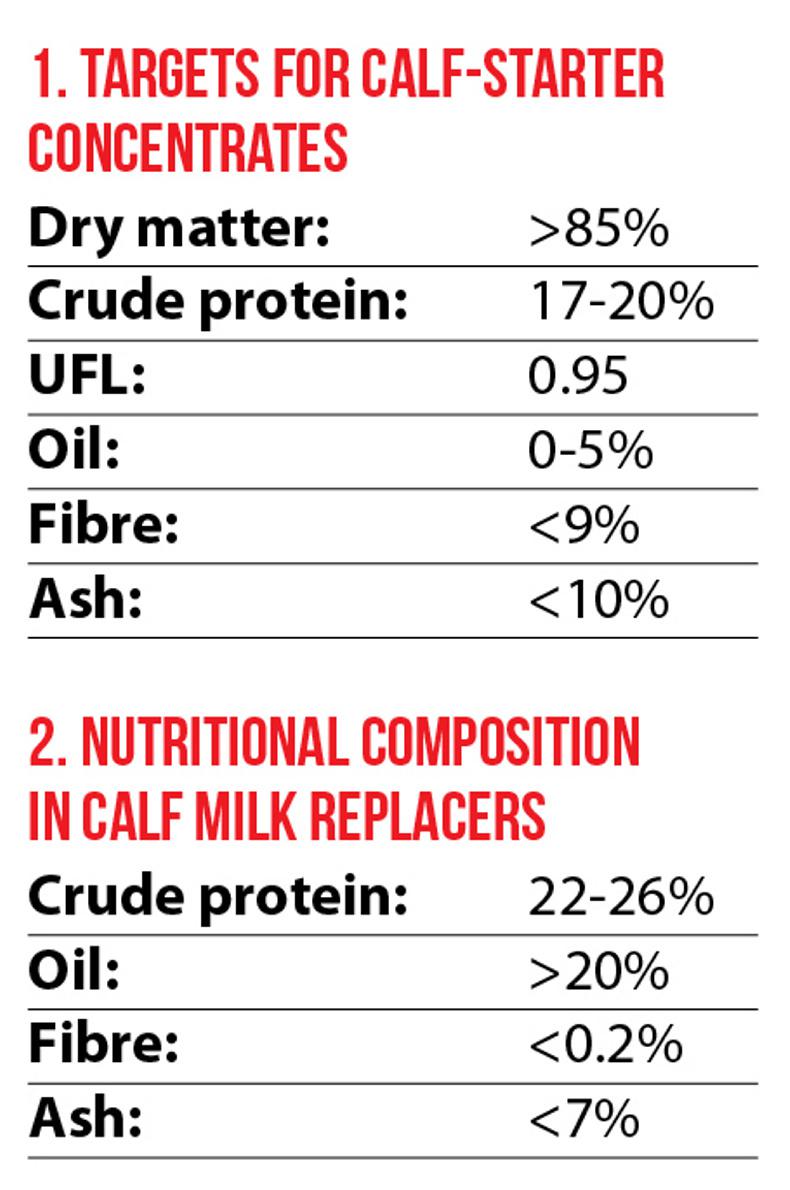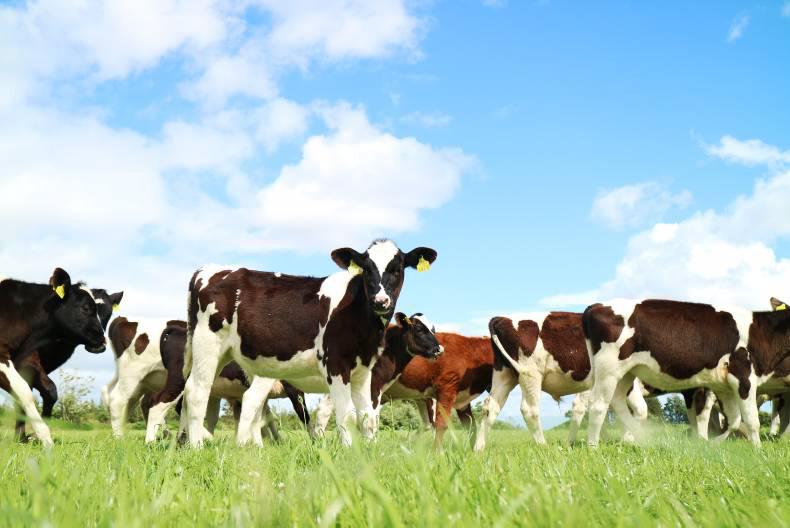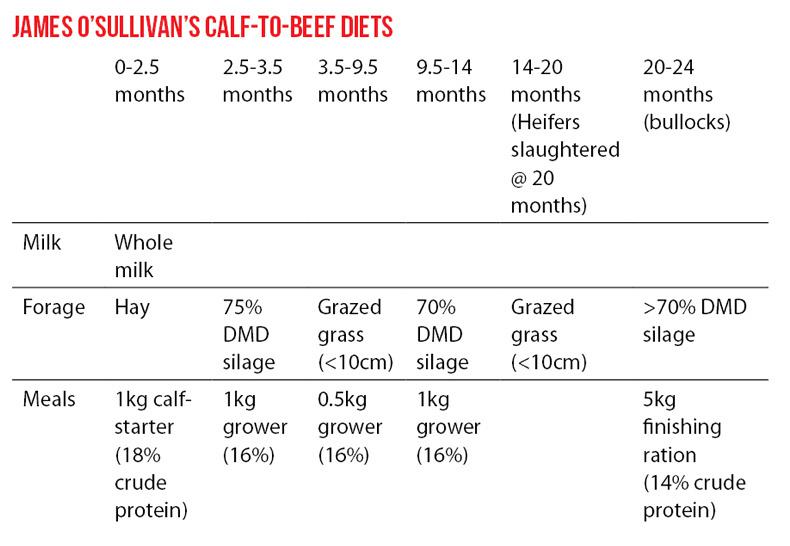There are three core fundamentals at the heart of every successful beef system: animal, management and feed. A good animal must be managed well and fed correctly.Seeing a golden opportunity with cheap calf prices, many have leapt head first into dairy calf-to-beef systems. When done right, they can be lucrative. But if the focus on these core beef fundamentals weakens, things can take a nasty, expensive turn.
There are three core fundamentals at the heart of every successful beef system: animal, management and feed. A good animal must be managed well and fed correctly.
Seeing a golden opportunity with cheap calf prices, many have leapt head first into dairy calf-to-beef systems. When done right, they can be lucrative. But if the focus on these core beef fundamentals weakens, things can take a nasty, expensive turn.

James O’Sullivan’s dairy calf-to-beef enterprise is built staunchly upon these fundamentals.
He farms at Glenville, Co Cork, on three blocks of land totalling 260 acres. James milks 80 British Friesian cows, but places a big emphasis on his beef and forestry enterprises also. The herd calves in February and March.
All male calves are finished for beef on the farm, as are any non-replacement heifers. Friesian is used at the beginning of the season, but after that a Hereford bull takes the reins and sires most of James’s calves.
Bullocks are finished at 22-24 months out of the shed, while heifers go younger at 20-22 months. Seventy per cent of heifers are slaughtered straight from grass. Target carcase weights for bullocks and heifers are 330kg and 250kg, respectively. Bullocks typically grade R and heifers generally hit O+.
The most important week in the whole system is the first one. Getting biestings into the calves sets them up to work for me
While the heifer carcases are light, James points out the fattening power of the Hereford.
“They’re hitting 4L fat scores at that weight. Her feed efficiency is beginning to drop off and I’m in danger of pricing penalties. The carcase is light, but so is the bill – her diet will have been 100% grass for the complete season.”
The Hereford-British Friesian cross is perfect for this dairy-beef system. Young calves are robust and have the ability to thrive in a grass-based system as they mature. James has sewn up the first fundamental with the perfect animal.

Rearing
Nutrition for the dairy beef calf is not straightforward. In the first weeks of life, the challenge is keep the animal healthy and make the transition from milk to roughage/concentrate-based diets. All the while, growth must be maximised.
James’s calves receive biestings for two days and then whole milk from birth right through to weaning and he’ll tell you himself just how important this is to the system’s success.
“With the milk price at present, it makes sense to give the whole milk. I’m of the firm opinion that the most important week in the whole system is the first one. Getting biestings into the calves sets them up to work for me.”
James’s pre-weaning mortality in 2016 was 3.8%, which stacks up well against the national data. Moorepark researchers estimate that calf mortality ranges from 3% to 15% on Irish dairy farms.
Calves get three litres of whole milk twice daily for eight to 10 weeks. During this period, hay and concentrate mix are readily available and the aim is to begin weaning calves once 1kg of meals are being consumed daily. At this point, milk is pulled back to once a day feeding and gradually phased out over a week.

Calf concentrates
Getting concentrates into young calves pre-weaning is crucial. A newborn calf’s stomach is unable to digest forages initially and concentrates stimulate its development. An animal’s diet affects the ratio of acids produced in the stomach and concentrate feeds drive production of propionic acid, the most important for stomach (rumen) development in the young calf. The generic target for the initiation of weaning is when 1kg of meals are being eaten, but many don’t wean completely until a calf is eating 1.5kg daily for three days.
A calf starter-concentrate is among the most expensive feeds in a beef system. While the temptation will be there to skimp on concentrate quality, it simply must be avoided. The animal needs to grow continually, without any check, and its stomach must develop sufficiently.
The ration should be coarse to stimulate and promote development of the stomach wall. Finely ground calf rations should be avoided. Starter rations will typically contain high amounts of soya bean and highly digestible cereal-based ingredients. Many will also contain additives that enhance digestibility and though these can help performance, they are not vital.

James’s ration compares well with the targets in Table 1. His starter ration is 18% crude protein, 4.8% oil, 7% NDF and 7.5% ash. It contains high amounts of soya bean and barley flakes, as well as wheat, maize and a small amount of sugar beet pulp and molasses to promote palatability. Buffers and yeast are also included in small amounts to maximise digestion.
While nothing beats whole milk for young calves, milk replacers are the sole option for many producers. However, their quality varies significantly – you get what you pay for. When mixing milk replacer, add 130g of powder to 870ml of warm water. Aim to feed at 40°C.
Table 2 outlines the targets for nutritional composition in calf milk replacers.
Once weaned, James’s calves head to slatted pens until weather permits turnout to grass, which is usually in early May. On the slats, the calves’ diet is based on high-quality grass silage bales (>75% DMD) and 1kg of a growing concentrate. When the calves get to grass, meal allowance is pulled back to 0.5kg daily. In truth, the meal at grass is mainly to facilitate herding – grass is the cornerstone farm performance once the calf heads outdoors. James puts a lot of time and effort into keeping grass quality high. He aims for a pre-grazing height of 10cm – any fields that become strong are taken out for bales and form the basis of the calves’ pre-turnout and winter diets.
“I attend local dairy discussion groups and main topic more often than not is grass and, more importantly, managing the stuff. I see it in my bulk tank when the quality dips; it’s the same for the beef calves. I think more beef men are coming around the potential benefits of managing grass. Some of them are beginning to show up at our meetings!”

Effective grassland management is a must in any beef system, but in a calf-to-beef system anything less than the best possible quality swards ahead of calves defies logic. Why spend hundreds of euro on the top of the range milk replacer and calf starter rations, only to let calves out into a mediocre feed source for the remainder of the year? The feeding value of well-managed grass will be over 10% better than that of poorly managed grass and, in addition, a proper grass management protocol will allow for more stock to be carried – double rewards.
James’s grower ration has a lower protein concentration (16%) than his starter ration. A calf’s requirement for protein lessens as he grows and grazed grass is also high in crude protein, though its concentration fluctuates during the year.

Growing ration
The growing ration contains barley, maize gluten, maize meal, palm kernel, rapeseed meal, maize distillers, molasses and a buffer. The lack of soya bean meal in the ration makes it more cost-effective. Instead, the protein sources are maize gluten, palm kernel, rapeseed meal and maize distillers.
After a long grazing season, animals are housed in mid-November. The diet here is grass silage supplemented with 1kg of the growing nut. Pit silage is fed during the winter, which in the winter of 2015/16 was 70% DMD. Meal allowance is dependent on silage quality. The aim for the first winter is a daily weight gain of 0.5-0.7kg, which is attainable with this combination. However, a 4% drop in DMD requires an extra 1kg of concentrate to maintain this rate of growth.
Teagasc work shows there is no financial gain at slaughter time where animals are fed on for the winter and then turned out to grass, relative to animals restricted during the winter, such as James’s, and then turned to grass. The restricted animals will compensate and have made up the difference by late summer.
Meals are pulled on St Patrick’s Day, to transition the calf to an all-forage diet in preparation for turnout. At this point, the animals are approximately one year old. These are the last meals most of James’s heifers will see.
Bullocks and any heifers not finished from grass are housed religiously in mid-October.
“I don’t have faith in grass beyond that point. The dry matter drops, the weather is bad – the best it’s doing is maintaining them,” he said.
The bullocks’ finishing diet is based on grass silage and a fattening concentrate. High-DMD, surplus bales are fed to the finishing cattle. Initially 2kg of the concentrate is offered and this is gradually built up to 5kg. The finishing concentrate is 14% crude protein. These animals have framed-up sufficiently, the aim of the finishing period is to lay down sufficient fat to satisfy the grader. Energy is the main driver of fat deposition.
James’s bullocks are slaughtered in batches as they become fit.
This article is taken from the Feed Guide magazine, the current edition of which is available to buy here. 




SHARING OPTIONS: